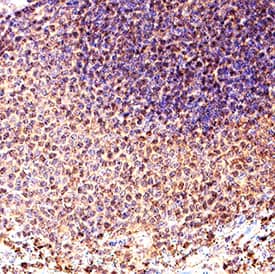Human LEF1 Antibody
R&D Systems, part of Bio-Techne | Catalog # MAB7647

Key Product Details
Species Reactivity
Applications
Label
Antibody Source
Product Specifications
Immunogen
Accession # Q9UJU2
Specificity
Clonality
Host
Isotype
Scientific Data Images for Human LEF1 Antibody
Detection of LEF1 in Human Spleen Tissue.
LEF1 was detected in Formalin Fixed fixed Paraffin Embedded sections of human spleen tissue using Mouse Anti-Human LEF1 Monoclonal Antibody (Catalog # MAB7647) at 5 µg/ml for 1 hour at room temperature followed by incubation with the Anti-Mouse IgG VisUCyte™ HRP Polymer Antibody (Catalog # VC001). Before incubation with the primary antibody, tissue was subjected to heat-induced epitope retrieval using VisUCyte Antigen Retrieval Reagent-Basic (Catalog # VCTS021). Tissue was stained using DAB (brown) and counterstained with hematoxylin (blue). Specific staining was localized to the cytoplasm and nucleus. View our protocol for Chromogenic IHC Staining of Paraffin-embedded Tissue Sections.Applications for Human LEF1 Antibody
Immunohistochemistry
Sample: Human Spleen Tissue
Formulation, Preparation, and Storage
Purification
Reconstitution
Formulation
Shipping
Stability & Storage
- 12 months from date of receipt, -20 to -70 °C as supplied.
- 1 month, 2 to 8 °C under sterile conditions after reconstitution.
- 6 months, -20 to -70 °C under sterile conditions after reconstitution.
Background: LEF1
LEF1 (Lymphoid Enhancer-binding Factor 1) is a functionally diverse member of the TCF/LEF family of transcription factors. The name LEF1 was originally applied to the mouse factor, while its human counterpart was named TCF-1 alpha. Since there is a related molecule named TCF-1, to avoid confusion with TCF-1 alpha, both species factors are now called LEF1. Although its predicted MW is 44 kDa, it runs anomalously at 35-55 kDa in SDS-PAGE. LEF1 has restricted expression in adult, being limited to T cells, thymocytes, pre-B cells and NK cells. LEF1 demonstrates sequence-specific (CCTTTG[T/A][T/A]) DNA binding and directs beta-catenin to Wnt‑responsive genes. Either transcriptional activation or repression may occur on LEF1 target genes, depending upon 1) the cofactors recruited to the LEF1: beta‑catenin complex, and 2) the phosphorylation state of LEF1. Human LEF1 is 399 amino acids (aa) in length. It contains one DNA-binding HMG-box (aa 298‑369), three potential phosphorylation sites, and an N-terminal SUMOylation site at Lys27. There are at least five isoform variants. One utilizes an alternative start site at Met116, a second contains a 47 aa substitution for aa 283‑299, and a third combines the previous two variations. A fourth variant shows a deletion of aa 214‑241, while a fifth variant combines the afore mentioned deletion of aa 214-241 with a 25 aa substitution for aa 390‑399. Over aa 120‑280, human LEF1 shares 97% aa sequence identity with mouse LEF1.
Long Name
Alternate Names
Gene Symbol
UniProt
Additional LEF1 Products
Product Documents for Human LEF1 Antibody
Product Specific Notices for Human LEF1 Antibody
For research use only
